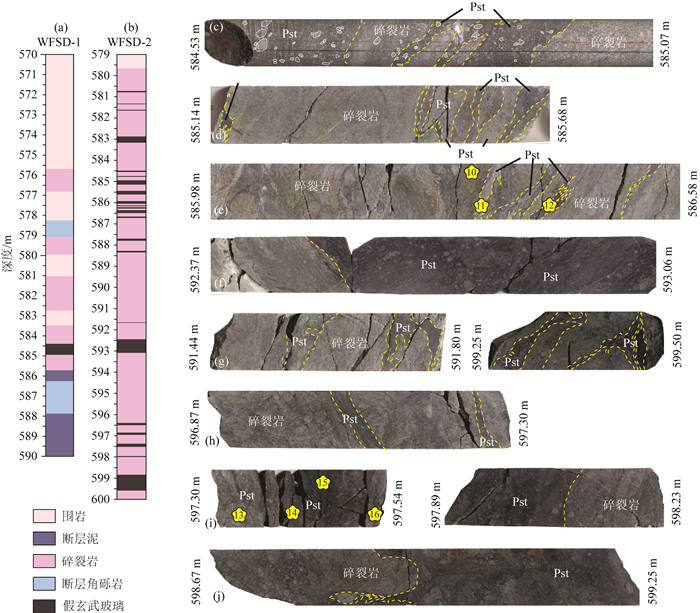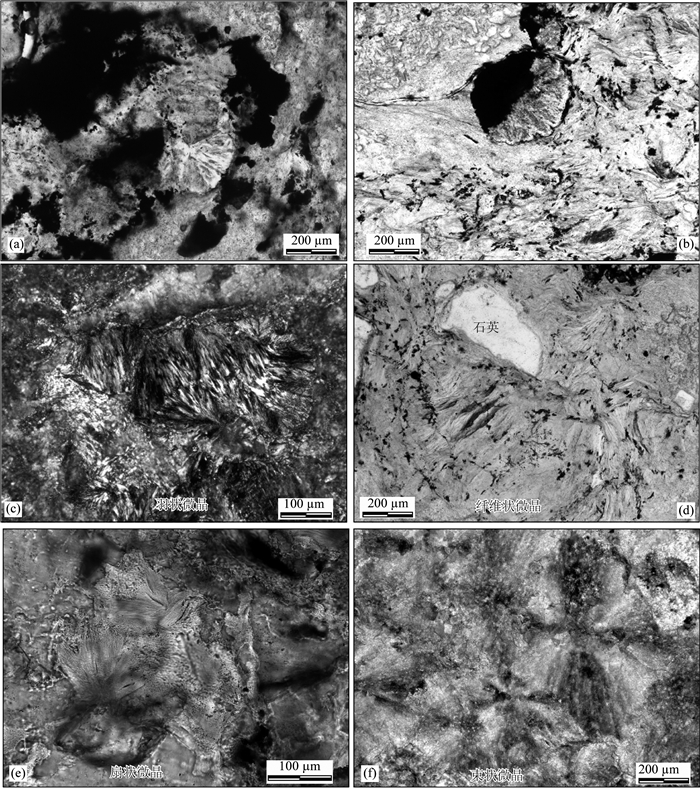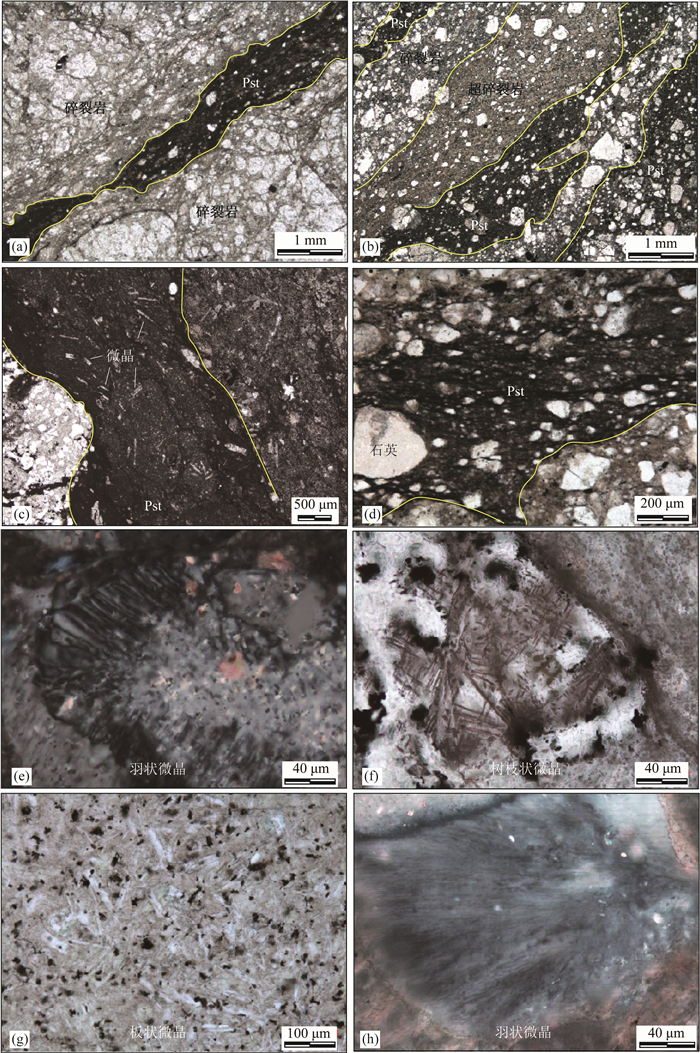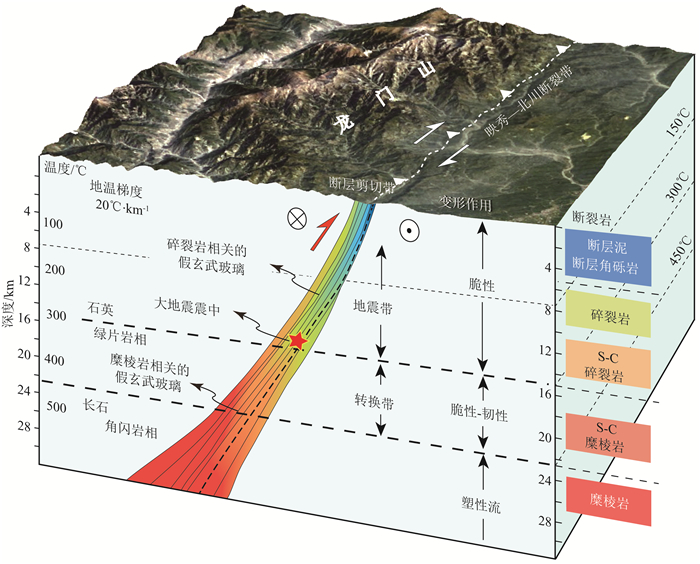2. 自然资源部古地磁与古构造重建重点实验室, 中国地质科学院地质力学研究所, 北京 100081
2. Key Laboratory of Paleomagnetism and Tectonic Reconstruction of Ministry of Natural Resources, Institute of Geomechanics, Chinese Academy of Geological Sciences, Beijing 100081, China
假玄武玻璃也称为假熔岩,由玻璃质基质和碎斑组成,形成于大地震、滑坡及陨石撞击等极端环境下(Ferré et al., 2005).与断层相关的假玄武玻璃通常被喻为“地震化石”(Cowan, 1999),在不同构造环境,如在内陆断层带(Sibson, 1975; Magloughlin, 1992)、碰撞造山带(Austrheim and Boundy, 1994; Lin et al., 2003)及板块俯冲带内(Ikesawa et al., 2003; Austrheim and Anderson, 2004)均有报道.板块边界俯冲和碰撞带主要以发生大震级的地震为特征,囊括了全球地震活动能量的95%以上,而文献资料记载的假玄武玻璃,超过95%形成于板内断层带中,其余部分发育于地质历史时期伴随着陆内断裂带的隆升剥蚀而出露于地表的板块俯冲及碰撞造山带中.关于假玄武玻璃的成因机制,目前具有争论的主要有两种,一种是摩擦熔融机制(McKenzie and Brune, 1972),另一种是强烈的磨蚀作用(Wenk, 1978).假玄武玻璃作为地震断裂带内的重要物质组成,其结构组成、岩石学及地球化学特征等可以作为约束地震震源参数的指标,为地震断层研究提供多种参数信息,如同震断层滑动时的温压环境、物质转换、断层强度、地震能量估算(Kanamori and Brodsky, 2004)、动态摩擦热(McKenzie and Brune, 1972)、断层滑移过程(Lin et al., 2003; Spray, 2005; Di Toro et al., 2006)和断层弱化距离(Hirose and Shimamoto, 2005)、抗剪切应力(Sibson, 1975; Di Toro et al., 2005)以及地震活跃周期中断层带内物理化学变化等.假玄武玻璃通常形成于地下大于4 km深度的地壳相对较深的部位(Lin, 2008),有些甚至可达岩石圈地幔深度(Ferré et al., 2017; Ferrand et al., 2018; Ueda et al., 2008),常与碎裂岩或糜棱岩伴生,后期经断裂带的抬升及剥蚀作用出露地表.研究剥露断裂带内的假玄武玻璃可以帮助我们理解断裂机制和地震相关变形过程(Swanson, 1992; Rowe et al., 2012).
龙门山断裂带一直是地学研究的热点,特别是在2008年汶川MW7.9大地震之后,很多研究组在该地区开展了众多的研究调查,汶川地震断裂带科学钻探(WFSD)在震后快速实施(许志琴等, 2008),获取了地下深部断层活动的物质,为我们深入认识龙门山断裂带提供了宝贵的研究材料.本文在区域调查及汶川科钻岩心研究的基础上,对映秀—北川断裂带南段地表露头以及科钻1号孔(WFSD-1)和2号孔(WFSD-2)岩心中发育的假玄武玻璃进行详细的描述分析,探讨其成因机制及断层弱化的相关信息,为理解映秀—北川断层滑动行为和龙门山隆升提供重要依据,有助于更好理解壳内断层地震成因,为地震预测和早期预警提供辅助参考.
1 地质背景青藏高原东缘活动断裂极其发育,北部为NWW向的东昆仑(走滑)断裂带;南部为NW向鲜水河(走滑)断裂带;它们之间东部为NE向的龙门山断裂带.龙门山断裂带北起广元,南至天全,长约500 km,宽约30 km,呈北东—南西向展布,北东与大巴山相交,南西被鲜水河断裂斜截.在整个高原周缘地区,龙门山区域地形坡度最陡、梯度变化最大,与川西前陆盆地地形高差可达5000 m(Densmore et al., 2007),不仅是我国东西部一级地貌边界带,同时也是我国南北地震带的重要组成(邓起东等, 1994).龙门山地区的强烈褶皱和地形特征也表明其为一条规模巨大的地震活动带.按照板块构造理论的观点,龙门山断裂带位于扬子板块的西北部,其西部为松潘—甘孜褶皱带,北为秦岭板块俯冲碰撞造山带的米仓山地体和大巴山逆掩构造体,西南为康滇地轴,属于松潘—甘孜造山带前缘逆冲带(许志琴等, 1992).龙门山断裂带经受长期地质构造演化,具有十分复杂的地质结构和演化历史(许志琴, 2007; Burchfiel et al., 1995),其主要由走向N30°E、倾向NW的大致平行的3条逆冲断裂组成(图 1),自西向东分别为汶川—茂县断裂、映秀—北川断裂和灌县—安县断裂(李勇等,2006).这3条断裂在垂向上呈叠瓦状向四川盆地内逆冲推覆,断裂倾角在近地表处较高,随深度向下逐渐变缓,最终在地下深部收敛聚合为一条剪切带,成为青藏高原推覆于四川盆地之上的主要控制构造(Burchfiel et al., 1995, 2008; 许志琴, 2007; 张培震等, 2008).龙门山逆冲推覆构造从晚三叠世开始并继续活动(许志琴等, 2007; 王焕等, 2017),其运动性质为走滑-逆冲型,晚三叠至古近纪时期表现为逆冲-左旋走滑特征(李勇等, 2006),中新生代以来以逆冲-右旋走滑作用为主(李勇等, 2006; Densmore et al., 2007).GPS观测显示其现今构造变形速率不超过2 mm·a-1(张培震等, 2008),没有显著的地壳缩短作用.龙门山断裂带作为一个孕震体系,发生类似于2008汶川MW7.9地震的强震复发周期估算为2000~6000年(李海兵等, 2008a; 李勇等, 2006; 张培震等, 2008).

|
图 1 龙门山区域构造地质图及汶川科钻钻孔位置 (a)龙门山区域构造地质图(据Wang et al., 2015修改);(b)研究区卫星影像(谷歌卫片)显示WFSD-1、WFSD-2钻孔及地表露头(黄色星号)位置. Fig. 1 Map showing geology of the Longmen Shan and adjacent area and the WFSD drilling sites (a) Geological map of the Longmen Shan area (modified after Wang et al., 2015); (b) Satellite image (from Google Earth) shows the locations of the WFSD-1, WFSD-2 drilling sites and the outcrop (yellow star). |
2008年汶川地震发生在龙门山断裂带,造成映秀—北川和灌县—安县两条断裂同时产生破裂(李海兵等, 2008b; 刘静等, 2008; 徐锡伟等, 2008; Fu et al., 2011),震后沿破裂带快速实施了汶川地震断裂带科学钻探项目(WFSD).汶川科钻1号孔(WFSD-1)和2号孔(WFSD-2)位于映秀—北川地表破裂带南段虹口八角庙地区(图 1).汶川地震在该区域造成了6.0~6.5 m的最大垂直位移量和2~3 m的水平位移量(李海兵等, 2008b; Jia et al., 2010).
2 假玄武玻璃宏观特征 2.1 八角庙地表露头映秀—北川断裂带南段虹口八角庙地区发育的假玄武玻璃与碎裂岩类岩石伴生(图 2).碎裂岩类岩石包括初碎裂岩、碎裂岩和超碎裂岩,其原岩均为花岗质岩石.碎裂岩和初碎裂岩均为浅灰色,在地表露头上不易区分.超碎裂岩颜色较深,包含较小的棱角状到次棱角状的碎块.假玄武玻璃以断层脉、注入脉和网状脉等形式发育于碎裂岩中.断层脉沿断层滑动面产生,呈薄层状,一般为几厘米到10 cm厚,因断层面的凹陷,局部可形成直径大于10 cm的块体(图 2b—2d).注入脉一般是在与膨胀相关的熔融热增压环境下,沿断层面周围裂隙快速灌入围岩破碎带中形成脉体,与断层脉相比较,注入脉的形态一般比较复杂,多为不规则形态的复杂网脉状(图 2c—2d),也有一些外形简单的单个脉体(图 2e),平面上或呈透镜状及孤立状的小块体.在较厚的假玄武玻璃脉中可以看到暗色不透明基质中含有大量的次棱角状-次圆形的碎块,这些碎块主要为长石、石英矿物碎屑及碎裂岩碎块,在脉体中间分布较多,边缘较少.暗色基质中可见由不同颜色条带及定向排列的碎块组成的流动构造特征(图 2f—2h).

|
图 2 八角庙地表露头中假玄武玻璃特征 (a)远景照片显示发育假玄武玻璃的碎裂岩;(b)假玄武玻璃产出形态特征素描图;(c)不同颜色的假玄武玻璃断层脉及网状脉体特征;(d) 图2c的素描;(e—f)假玄武玻璃断层脉及注入脉;(g) 图2f的局部放大,显示不同颜色条带及流动构造;(h)不同颜色条带的假玄武玻璃.Pst为假玄武玻璃,Pst-1、Pst-2、Pst-3代表不同期次的假玄武玻璃.图中数字编号代表进行XRD分析的样品的采样位置.图2b—2d据Wang et al., 2015修改. Fig. 2 Features of pseudotachylytes in the Bajiaomiao outcrop (a) The panoramic photo shows the outcrop where pseudotachylytes developed; (b) A sketch shows features of the pseudotachylyte occurrence; (c) Pseudotachylyte veins of different colors; (d) Sketch of Fig. 2c; (e—f) Pseudotachylyte fault veins and injection veins; (g) Local amplification of Fig. 2f showing different color bands and flow structure; (h) Pseudotachylyte with different color bands. Pst-pseudotachylyte, Pst-1, Pst-2, and Pst-3 indicate pseudotachylytes of different generations. The numbers indicate the locations of samples taken for XRD analyses. Figs. 2b—2d are modified from Wang et al., 2015. |
WFSD-1钻孔设计为一口斜孔,位于映秀—北川断裂带南段虹口八角庙地区,终孔深度为1201.15 m,为全钻孔取心,平均岩心采取率为95.4%.其岩心在585.75 m以上为新元古代彭灌杂岩,主要由凝灰岩、火山碎屑岩、花岗岩、闪长岩等组成;585.75~598 m孔深为彭灌杂岩与须家河组的分界带,主要为断层泥和角砾岩,其中既有彭灌杂岩的物质又有沉积岩物质;598 m孔深以下为上三叠统须家河组地层,主要由青灰色-灰黑色的砂岩、粉砂岩、炭质泥岩以及煤线组成(Li et al., 2013),其中还有发育一些软沉积物变形的液化角砾岩(王焕等, 2017).
WFSD-1岩心中断裂岩主要分布于482~759 m,包括碎裂岩、假玄武玻璃、断层泥和断层角砾岩,其中碎裂岩和假玄武玻璃主要分布于575.7~585.75 m深度段(图 3a).假玄武玻璃呈深灰色-灰黑色发育于碎裂岩中(图 3c),其中碎块角砾清晰可见,多呈次圆形,主要为碎裂岩岩石碎屑及少量矿物碎屑.

|
图 3 汶川科钻岩心中假玄武玻璃分布及特征 (a) WFSD-1岩心570~590 m断裂岩分布;(b) WFSD-2岩心579~600 m断裂岩分布;(c)岩心扫描照片显示WFSD-1岩心中假玄武玻璃特征;(d—j)岩心对切后的扫描照片显示WFSD-2岩心中假玄武玻璃特征.图中数字代表进行XRD分析样品的采样位置. Pst—假玄武玻璃. Fig. 3 Pseudotachylytes in the WFSD drilling cores (a) Fault rocks distributed at 570~590 m-depth in the WFSD-1 drilling core; (b) Fault rocks distributed at 579~600 m-depth in the WFSD-1 drilling core; (c) Core scanning photo shows the pseudotachylyte in the WFSD-1; (d—j) Core scanning photos show the pseudotachylytes in the WFSD-2. The numbers indicate the locations of the samples for XRD analyses. Pst—pseudotachylyte. |
WFSD-2位于WFSD-1北约300 m位置(图 1b),终孔深度为2283.56 m,从500 m开始取心.整个钻孔岩心由3套彭灌杂岩与须家河相互叠置的构造岩片组成(张伟等, 2012).其中碎裂岩主要分布于512~600 m,断层泥和断层角砾岩分布于713.74~951.44 m,951.44 m以下仅有少量角砾岩零星分布.假玄武玻璃主要发育在580~600 m之间的碎裂岩中(图 3b),呈浅灰、深灰、灰白、棕色及黑色等多种颜色的窄条带、小团块、网状等形态(图 3d—3j).可见黑灰色与灰白色脉体近平行分布,而且两者之间具有明显的边界(图 3d—3e),在较厚的假玄武玻璃脉中分布较多大小不一的次圆形的岩石或矿物碎块(图 3f, 3i—3j).
3 假玄武玻璃微观特征及成分分析 3.1 显微结构假玄武玻璃及相关碎裂岩的显微结构是借助偏光显微镜及扫描电子显微镜进行观察的.碎裂岩具有碎裂结构,岩石大部分已经破碎为碎粒、碎粉,原岩结构已难以辨认.如图 4a所示,碎裂岩中棱角状到次棱角状的石英、长石碎粒,大小不均一,具有弱定向性排列,被细粒基质包围,基质含量约占30%~40%.与碎裂岩相比,超碎裂岩中的碎粒小且均一,多为次棱角状到次圆状的石英和长石碎粒,含量也更少,碎基分布相对均匀,多为细小的碎粉状,含量占70%~80%(图 4b—4c).假玄武玻璃在单偏光下呈浅灰、褐色到黑色,富细粒基质,含有许多次棱角状-次圆状的碎屑,碎屑大小不一,从厘米到纳米级均有分布(图 4b—4f).总体来看,从碎裂岩、超碎裂岩到假玄武玻璃,其中碎屑颗粒的粒度和不均一性逐渐减小,碎屑磨圆度和基质含量逐渐增加.碎屑在假玄武玻璃脉体中间分布较多,边缘相对较少.较大的碎粒边缘呈不规则的港湾状(图 4e—4f),暗色基质中可见明显的流动构造特征(图 4b, 4d—4e).假玄武玻璃与碎裂岩、超碎裂岩之间具有明显的边界(图 4b—4c).

|
图 4 八角庙露头中假玄武玻璃显微结构特征 (a)具弱面理化的碎裂岩;(b)假玄武玻璃及伴生的超碎裂岩呈陡变的接触关系,暗色基质可见流动构造;(c)不同期次假玄武玻璃与碎裂岩、超碎裂岩呈突变接触;(d—e)假玄武玻璃的流动构造特征;(f)具有港湾状熔蚀边的矿物碎粒分布于暗色基质中. Pst—假玄武玻璃,Pst-1、Pst-2指示不同期次的假玄武玻璃. Fig. 4 Microstructures of the pseudotachylyte from the Bajiaomiao outcrop (a) Weakly foliated cataclasite; (b) Pseudotachylyte and ultracatcalasite with sharp boundaries; (c) Sharp boundaries between pseudotachylyte, cataclasite and ultracataclasite; (d—e) Flow structure in pseudotachylyte; (f) Embayed fragments in the dark matrix of pseudotachylyte. Pst—pseudotachylyte, Pst-1, Pst-2 indicate pseudotachylytes of different generations. |
假玄武玻璃中通常会含有大量微晶,这些微晶是熔体在快速冷却过程中形成的形状各异的微小晶体,是熔融成因的假玄武玻璃的明显特征之一(Lin, 2008).我们在八角庙露头的假玄武玻璃中也发现了包括粒状、扇状、羽状、纤维状及复合球粒状等多种形状的微晶(图 5).球粒状微晶多为圆形或椭圆形(图 5a—5b),由许多微小的晶体组成,常常具富铁矿物形成的暗色边,有些球粒甚至被这些黑色物质覆盖一半.这些球粒边缘呈现凹凸不平的弧状,类似黏滞体流动特征,球粒周围为富含长石和云母的基质.图 5c所示为受强烈蚀变作用后保留在富碳酸盐物质中的羽状微晶残留体,由中间向边部其微晶颗粒逐渐变小.纤维状微晶为众多方向近一致的细小纤维状的物质(图 5d).扇形球粒微晶由白云母羽状微晶组成(图 5e).粒状微晶集合体主要为长英质矿物的细小晶体组,在单偏光镜下显示比较均一的性质,几乎不能分辨出单个的微晶颗粒,但是在正交偏光镜下,转动载物台时,这类微晶集合体呈现出十字消光的特征,并且可以看到不同消光的微小晶体颗粒(图 5f).

|
图 5 八角庙露头中假玄武玻璃微晶形态特征 (a—b)球粒状微晶;(c)羽状微晶;(d)纤维状微晶;(e)扇状微晶; (f)粒状微晶集合体.除图(c)和(f)为正交偏光外,其余均为单偏光.图(b), (e), (f)来自Wang et al., 2015. Fig. 5 Textures of microlite in the pseudotachylyte veins from the Bajiaomiao outcrop (a—b) Compound spherulitic microlites; (c) Plume-like spherulites; (d) Fibrous spherulites; (e) Fan-like spherulites; (f) Microlite aggregates. (c) and (f) are cross-polarized light, others are plane-polarized light. Figures (b), (e) and (f) are from Wang et al., 2015. |
与地表假玄武玻璃特征类似,显微镜下亦可见汶川科钻岩心中假玄武玻璃也与碎裂岩和超碎裂岩密切伴生(图 6a—6b).假玄武玻璃呈条带状分布于碎裂岩中,靠近假玄武玻璃的碎裂岩中碎粒更细小且基质含量增多(图 6a).假玄武玻璃多为黑色呈不规则形状侵入到碎裂岩和超碎裂岩中,并且相互之间具有清晰的边界(图 6b),在暗色基质中发育有针状及短柱状的微晶(图 6c)以及流动构造(图 6d).此外我们在岩心假玄武玻璃中也观察到有羽状(图 6e, 6h)、树枝状(图 6f)以及板状(图 6g)等多种形态的微晶.

|
图 6 WFSD岩心中假玄武玻璃显微结构及微晶特征 (a—d)与碎裂岩、超碎裂岩伴生的假玄武玻璃特征,不同岩性之间边界明显;(c)中可见针状、短柱状微晶;(d)中流动构造明显;(e)羽状微晶;(f)树枝状微晶;(g)板条状微晶;(h)羽状微晶. Fig. 6 Microstructures and microlites in the pseudotachylyte from WFSD drilling cores (a—d) Pseudotachylyte and associated cataclastic rocks with sharp boundaries; Acicular and lath-like microlites can be seen in figure (c), and flow structure shown in figure (d); (e) Plume-like spherulites; (f) Dendritic microlites; (g) Lath-like microlites; (h) Plume-like spherulites. |
我们在扫描电镜下对八角庙地表和汶川科钻岩心中的假玄武玻璃进行了表面特征观测,结果显示在假玄武玻璃中发育大量微晶及熔融结构特征(图 7).地表假玄武玻璃中发育很多细小的蜂窝状气孔构造(图 7a)、熔融体流动构造(图 7b)和微晶等指示熔融成因的结构特征(Wang et al., 2015).同样在岩心样品中我们也观察到大量熔融结构特征(图 7c—7i),包括熔融体流动形成的带状(图 7c)及拉伸的丝线状(图 7e)条带、微小熔体团块及沿矿物碎块边缘生长的微晶(图 7d)、熔体内部生长出来的粒状(图 7e)、细板状和小球粒状微晶(图 7f)、石英碎块的港湾状熔蚀边(图 7f)以及大量具有圆核、环边结构的圆形-椭圆球粒的微晶(图 7g—7i).

|
图 7 扫描电镜下假玄武玻璃微观特征 (a)蜂窝状气孔构造;(b—c)熔融体流动特征;(d)熔融体小团块和微晶;(e)丝线状熔融体及粒状微晶;(f)板条状、球粒状微晶和港湾状熔蚀边;(g—i)具有核部和环边结构的球粒状微晶.图(b)来自于Wang et al., 2015. Fig. 7 SEM images showing melt structures in pseudotachylytes (a) Honeycomb-like vesicles; (b—c) Typical melt flow structures; (d) Melt patches and microlites; (e) Melt strings and microlites; (f) Lath-like and granular microlites and embayment; (g—i) Zoned spherulites. Image (b) is from Wang et al., 2015. |
假玄武玻璃和碎裂岩的矿物组成是通过粉末X射线衍射(XRD)分析确定的.XRD分析在北京北达燕园微组构分析测试中心进行的.在八角庙地表露头中采集了9个样品(样品位置见图 2);在岩心中采集了7个样品(采样位置见图 3).样品简要描述和分析结果见表 1,对应XRD分析的图谱如图 8所示.采自八角庙露头的假玄武玻璃样品的衍射图谱与碎裂岩的差别不大,部分假玄武玻璃样品在2θ低角度位置隐约显示一个宽峰带(图 8a).岩心样品分析的结果显示,除样品Pst-12显示在18°~38°之间具有较明显的宽峰带之外,其余假玄武玻璃也不太明显(图 8b).这个低角度的宽峰带指示样品是否存在玻璃质(即非晶质)物质.
|
|
表 1 假玄武玻璃和碎裂岩的矿物成分 Table 1 Mineral composition of pseudotachylytes and associated cataclasites |

|
图 8 假玄武玻璃和碎裂岩的XRD谱图 (a)八角庙露头样品分析结果;(b) WFSD岩心样品分析结果. Qz—石英, Pl—长石, Ms—云母, Cal—方解石, Ank—铁白云石, Sd—菱铁矿, Kln—高岭土, Ap—磷灰石, Pst—假玄武玻璃, Cata—碎裂岩. Fig. 8 XRD spectra of the pseudotachylytes and associated cataclasites (a) Spectra for samples from the Bajiaomiao outcrop; (b) Spectra for samples from the WFSD drilling cores. Qz—quartz, Pl—plagioclase, Ms—muscovite, Cal—calcite, Ank—ankerite, Sd—siderite, Kln—kaolinite, Ap—apatite, Pst—pseudotachylyte, Cata—cataclasite. |
与断层相关的假玄武玻璃通常被认为是地震过程中断层高速滑动摩擦的证据(Sibson, 1975; McNulty, 1995; Lin et al., 2003).通常熔融成因的假玄武玻璃中存在独特的熔融结构,如圆形或具港湾状熔蚀边的碎屑颗粒、流动构造、球粒状微晶、树枝状微晶、硫化气泡、气孔和杏仁构造等等(Sibson, 1975; Maddock et al., 1987; Lin, 1994; Camacho et al. 1995);而碾磨成因的假玄武玻璃中是没有这些特征的(Lin et al., 2001; Otsuki et al., 2009).Janssen等(2010)在超碎裂岩中发现非晶质物质,表明非晶质物质可以在碾磨作用下形成,而实验研究也证明了这一观点(Di Toro et al., 2004),Hirono等(2014)认为非晶质物质可能由超细颗粒在地震过程中碾磨形成.
从XRD分析谱图来看,大多数假玄武玻璃的峰值与碎裂岩的相似,没有出现明显的如富蕴假玄武玻璃中的玻璃质的宽峰带(Lin, 2008),岩心样品中只有一个假玄武玻璃(Pst-12)在2θ低角度区域有较明显的宽峰(图 8b),地表假玄武玻璃样品Pst-4、6、8、9中隐约可以看到一些宽峰(图 8a).假玄武玻璃谱图中的这些峰值可能代表了其蚀变或脱玻化作用的产物,因为玻璃质物质在其形成的地质环境中是很不稳定的(Lin, 2008),在漫长的地质历史时期中很容易发生蚀变或变质作用.事实上目前报道的自然界中多数熔融成因的假玄武玻璃中并没有玻璃质或是非晶质物质(Lin, 2008),除玻璃质不易保存外,另一个可能的原因是假玄武玻璃中玻璃质或非晶质的体积本来就比较小,在与矿物碎块混合后,很难从谱图中区分出来.因此,玻璃质或非晶质的出现并不是判断假玄武玻璃熔融成因的必要条件.但是映秀—北川断裂带中的假玄武玻璃发育很多其他熔融成因的特征构造,例如流动构造(图 4d—4e、6d、7b—7c)、蜂窝状气孔构造(图 7a)、具港湾状熔蚀边的碎块(图 4e—4f、7f),以及球状、羽状、纤维状、粒状等多种形态的微晶集合体(图 5c—5f、6e—6h、7d—7i).这些特征构造都明显指示其为熔融成因.石英残余颗粒的港湾状熔蚀边、流动构造以及石英颗粒中的蜂窝状气孔结构等都表明其断层滑动摩擦作用的局部温度达到了石英的熔融温度1730 ℃(Spray, 1992).岩石磁学研究发现这些假玄武玻璃具有较高的磁化率,也表明其经历了摩擦热的作用(Pei et al., 2014; Zhang et al., 2017).因此,我们认为映秀—北川断裂带的假玄武玻璃是熔融成因的.
此外,从宏观和微观特征中均可看到假玄武玻璃呈不同颜色条带并成相互穿插关系(图 2c—2d, 2f—2h, 4c).从宏观特征来看,较新的假玄武玻璃脉通常颜色较深,而早期的假玄武玻璃经过蚀变或脱玻化作用常呈现灰色-浅灰、棕色-浅褐色.因为一次地震事件很难产生多层具有截然边界的不同颜色的假玄武玻璃(Shigetomi and Lin, 1999),所以多层不同颜色的假玄武玻璃可能代表了不同时代的地震事件.较新的假玄武玻璃中包含早期形成的假玄武玻璃碎块也表明其为多期次形成的(Wang et al., 2015),同时也说明产生假玄武玻璃的地震事件沿该断裂是重复发生的.这与我们认知的大地震在成熟活动断裂带内重复发生是一致的,即多次大地震事件沿映秀—北川断裂带重复发生.
4.2 断层同震弱化机制断层的弱化机制是近几十年来断层滑动过程研究中最具争议的课题之一,目前提出的弱化模式主要有以下几种:热增压机制(Mase and Smith, 1987; Wibberley and Shimamoto, 2005)、熔融润滑机制(McKenzie and Brune, 1972; Spray, 2005; Di Toro et al., 2006)、动态润滑机制(Brodsky and Kanamori, 2001)、机械润滑机制(Ma et al., 2003)、硅胶润滑机制(Di Toro et al., 2004; Kirkpatrick et al., 2013)、粗糙面接触点的瞬间加热机制(Rempel, 2006; Rice, 2006)、热分解(Han et al., 2007)以及与断层泥相关的弱化作用(Chambon et al., 2002)等.野外调查和断裂岩显微结构的观察对研究断层在古地震过程中的滑动弱化机制具有非常重要的指示意义,因为断层滑动过程产生的变形机制信息可能会保留在断裂岩中.
映秀—北川断裂带中的假玄武玻璃具有大量熔融成因的特征,如石英和长石碎块的港湾状熔蚀边、多种微晶以及特征流动构造等.熔体在地震断层滑动过程中是起润滑作用(McKenzie and Brune, 1972; Hirose and Shimamoto, 2005; Di Toro et al., 2006)还是因其黏滞性而阻碍断层滑动(Fialko and Khazan, 2005),很多研究者已探讨过.在快速剪切过程中,断层中单个颗粒之间的机械作用使得温度升高,并从颗粒表面向其内部加热,颗粒表面的温度不断升高,因而发生熔融.熔体通过加强其蠕变速率和降低其黏度而直接影响岩石的强度(Kohlstedt and Holtzman, 2009).高速摩擦实验的结果表明,摩擦熔融产生的熔体在低压条件下,可能会因为其黏滞性而使得断层强度增加;但是在高正常应力作用下,由于剪切加热和碎屑熔融使得熔体黏滞性降低,断层的动态摩擦力显著降低,甚至形成完全的应力降(Fialko and Khazan, 2005).在这一过程中发生熔融润滑作用,形成一个有效的断层滑动弱化机制(McKenzie and Brune, 1972; Di Toro et al., 2006).熔体的黏滞性在较大深度时会相对减小(Fialko and Khazan, 2005),而映秀—北川断裂带中的假玄武玻璃形成于地下~11—14 km的深度(郑勇等, 2017),相对于断层滑动的巨大能量,熔体的瞬态黏滞性作用可能非常小.针对摩擦熔融的高速实验也表明,地震期间若断层带中形成足够量的摩擦融熔体,那么断层带的强度将会大大降低.因此我们认为映秀—北川断裂带中古地震断裂过程中存在摩擦熔融润滑作用.
熔融体的产生本身就是一个增压的过程.在断层滑动的最初阶段,摩擦作用很容易使断层面上的温度升高,断裂带内不透水围岩层间流体因加热扩张,其压力增加达到岩石静流体压力时,这时断层滑动几毫米到厘米的距离就能为热增压提供足够的能量(Mase and Smith, 1987; Melosh, 1996).在这种情况下,超细粒-细粒物质就可能被液化然后快速贯入断层面周围的裂隙中.因此,热增压在形成假玄武玻璃注入脉的过程中起非常重要的作用.如果断裂带内的流体被封存在一定空间并在断层滑动过程中经摩擦加热,流体压力可能会显著增高,作用在断层面上的有效正应力则减小,从而减小地震滑动过程中断层强度(Rempel and Rice, 2006; Rice, 2006; Han et al., 2014).
此外,映秀—北川断裂带中的假玄武玻璃与碎裂岩密切相关.在断层滑动的早期阶段,较大的碎块因断层滑动而滚动、破裂,形成细小颗粒,流体因为热作用可以被从断裂带中挤压出来.细小的颗粒与流体可以形成一种悬浮液.在这种条件下,热增压作用是不可能发生的,而机械润滑可能就成为主要的弱化机制(Vinciguerra and Bernabé, 2009),因为热增压作用只能发生在存在流体较多的条件下,而机械润滑作用则可以发生在主要为固体小颗粒的组成的条件下(Brodsky and Kanamori, 2001).因此我们认为映秀—北川断裂带古地震断层滑动过程中也存在机械润滑作用.综上所述,在映秀—北川断裂带内存在多种断裂弱化机制的证据,表明同震滑动过程中可能存在多种弱化机制共同作用,如摩擦熔融润滑机制、热增压机制和机械润滑机制等,不同弱化机制可能在地震断层滑动的不同阶段起主导作用.
4.3 假玄武玻璃与龙门山隆升的关系断裂岩是断层活动的重要标志和信息载体,记录和影响断层的孕震行为.映秀—北川断裂带假玄武玻璃均发育于新元古代彭灌杂岩中,与碎裂岩密切伴生并叠置于晚三叠世须家河组沉积岩之上,表明其形成于地下深部,经后期抬升剥蚀而出露于地表或近地表.依据Swanson(1992)提出的大型走滑断裂带模型来看,断层泥和角砾岩一般形成于近地表到~100 ℃温度范围,碎裂岩则形成于100~300 ℃温度范围,位于脆韧性转换带之上.假玄武玻璃通常与碎裂岩密切相关,也有少量与糜棱岩伴生.汶川科钻WFSD-1钻孔长期温度监测显示该区域地温梯度为~20 ℃·km-1(Li et al., 2015),据此我们提出映秀—北川断裂带断裂岩分布趋势图(图 9),石英变形温度300 ℃对应深度为15 km.典型大地震震中一般位于转换带上边界位置(Swanson, 1992),在龙门山地区相当于~15 km深度,这一深度与2008年汶川地震震源深度(~14—15 km, Rogozhin and Shen, 2011; Yang et al., 2012)基本一致.映秀—北川断裂带中假玄武玻璃与具弱面理化的碎裂岩出露在一起,推测其形成深度为~10—15 km.热年代学研究认为彭灌杂岩中的假玄武玻璃形成于晚三叠世时期(郑勇等, 2017),后期经历断裂带的长期地震活动抬升剥蚀~10—15 km而出露地表.

|
图 9 映秀—北川断裂带断裂岩分布示意图(据Swanson, 1992修改) 显示地震带、不同深度的变形作用和对应断裂岩类型、以及与碎裂岩和糜棱岩相关的假玄武玻璃分布. Fig. 9 Schematic diagram of the Yingxiu-Beichuan fault zone (modified from Swanson, 1992) showing the seismogenic zone Deformation at varied depths and related fault rocks as well as the distribution of pseudotachylytes within both cataclasitic and mylonitic fault zones. |
综合映秀—北川断裂带彭灌杂岩中的碎裂岩和多期次的假玄武玻璃,以及须家河组中发育的巨厚断层泥和断层角砾岩(Wang et al., 2014)来看,映秀—北川断裂带确实是一条经历长期地震活动的大断裂.汶川大地震后断裂带内渗透率快速降低(Xue et al., 2013),表明断裂快速愈合为下一次地震聚集能量,也从另一个方面反映映秀—北川断裂带重复发生多次地震活动的可能性.映秀—北川断裂带,作为龙门山主体中高山区和东缘中低山区的分界线,控制着区域地貌的分布(邓起东等, 1994)和龙门山的隆升,其长期地震活动造成的垂直位移量,可能是龙门山快速隆起的主要机制.
5 结论假玄武玻璃作为古地震的化石,其结构组分保留了断裂行为和机械性质的重要信息.本文借助偏光显微镜、扫描电镜以及XRD分析等多种手段,对汶川科钻钻孔(WFSD-1、WFSD-2)岩心及虹口八角庙地表露头中发育的假玄武玻璃进行综合分析研究,得出以下结论:
(1) 映秀—北川断裂带中发育灰色、棕色-褐色及黑色的假玄武玻璃,呈断层脉、单个注入脉以及网状注入脉等形式产出,脉体厚度从几毫米到数十厘米不等.假玄武玻璃中发育的针状、球状、羽状、纤维状、粒状等多种形态的微晶或微晶集合体,以及蜂窝状气孔构造、流动构造、港湾状熔蚀边等特征构造,指示其为断层摩擦熔融作用的产物,表明摩擦熔融润滑是古地震事件中断层滑动的主要弱化机制,同时断层滑动的不同阶段也存在热增压和机械润滑等弱化机制.
(2) 多种不同颜色的假玄武玻璃条带及其相互叠加关系表明映秀—北川断裂带中的假玄武玻璃是多期次形成的,表明产生假玄武玻璃的大地震事件在映秀—北川断裂带内重复发生.发育有断层泥、角砾岩、碎裂岩和假玄武玻璃等多种脆性断裂岩的映秀—北川断裂带是一条大地震频发的断裂带,作为龙门山地区最陡峭的地形边界,其长期的地震活动造成的地壳缩短加厚可能是龙门山快速隆升的一个主要原因.
致谢中国地质科学院地质研究所刘栋梁、吴建国、韩亮、李成龙、云锟,中国地质调查局探矿工艺研究所张佳佳等在地表及岩心样品采集中提供了大量的帮助,魏金川在薄片制备中给予极大帮助,施彬在扫描电镜观测分析中提供了帮助,在此一并表示衷心的感谢!特别感谢两位匿名评阅人提出的修改意见,使得本文更加完善.
Austrheim H, Boundy T M.
1994. Pseudotachylytes generated during seismic faulting andeclogitization of the deep crust. Science, 265(168): 82-83.
|
|
Austrheim H, Andersen T B.
2004. Pseudotachylytes from Corsica: Fossil earthquakes from a subduction complex. Terra Nova, 16(4): 193-197.
DOI:10.1111/ter.2004.16.issue-4 |
|
Brodsky E E, Kanamori H.
2001. Elastohydrodynamic lubrication of faults. Journal of Geophysical Research, 106(B8): 16357-16374.
DOI:10.1029/2001JB000430 |
|
Burchfiel B C, Chen Z L, Liu Y, et al.
1995. Tectonics of the Longmen Shan and adjacent regions, central China. International Geology Review, 37(8): 661-735.
DOI:10.1080/00206819509465424 |
|
Burchfiel B C, Royden L H, van der Hilst R D, et al.
2008. A geological and geophysical context for the Wenchuan earthquake of 12 May 2008, Sichuan, People's Republic of China. GSA Today, 18(7): 4-11.
DOI:10.1130/GSATG18A.1 |
|
Camacho A, Vernon R H, Fitz Gerald J D.
1995. Large volumes of anhydrous pseudotachylyte in the Woodroffe Thrust, eastern Musgrave Ranges, Australia. Journal of Structural Geology, 17(3): 371-383.
DOI:10.1016/0191-8141(94)00069-C |
|
Chambon G, Schmittbuhl J, Corfdir A.
2002. Laboratory gouge friction: Seismic-like slip weakening and secondary rate-and state-effects. Geophysical Research Letter, 29(10): 1366.
DOI:10.1029/2001GL014467 |
|
Cowan D.
1999. Do faults preserve a record of seismic slip?A field geologist's opinion. Journal of Structural Geology, 21(8): 995-1001.
|
|
Deng Q D, Chen S F, Zhao X L.
1994. Tectonics, seismisity and dynamics of Longmenshan Mountains and its adjacent regions. Seismology and Geology, 16(4): 389-403.
|
|
Densmore A L, Ellis M A, Li Y, et al.
2007. Active tectonics of the Beichuan and Pengguan faults at the eastern margin of the Tibetan Plateau. Tectonics, 26(4).
DOI:10.1029/2006TC001987 |
|
Di Toro G, Goldsby D L, Tullis T E.
2004. Friction falls towards zero in quartz rock as slip velocity approaches seismic rates. Nature, 427(6973): 436-439.
DOI:10.1038/nature02249 |
|
Di Toro G, Pennacchioni G, Teza G.
2005. Can pseudotachylytes be used to infer earthquake source parameters? An example limitations in the study of exhumed faults. Tectonophysics, 402(1-4): 3-20.
DOI:10.1016/j.tecto.2004.10.014 |
|
Di Toro G, Hirose T, Nielsen S, et al.
2006. Natural and experimental evidence of melt lubrication of faults during earthquakes. Science, 311(5761): 647-649.
DOI:10.1126/science.1121012 |
|
Ferrand T P, Labrousse L, Eloy G, et al.
2018. Energy balance from a mantle pseudotachylyte, Balmuccia, Italy. Journal of Geophysical Research: Solid Earth.
DOI:10.1002/2017JB014795 |
|
Ferré E C, Allen J L, Lin A M.
2005. Pseudotachylytes and seismogenic friction:An introduction to current research. Tectonophysics, 402(1-4): 1-2.
DOI:10.1016/j.tecto.2005.03.013 |
|
Ferré E C, Meado A L, Geissman J W, et al.
2017. Earthquakes in the mantle? Insights from rock magnetism of pseudotachylytes. Journal of Geophysical Research: Solid Earth, 122(11): 8769-8785.
DOI:10.1002/2017JB014618 |
|
Fialko Y, Khazan Y.
2005. Fusion by earthquake fault friction: Stick or slip?. Journal of Geophysical Research, 110(B12): B12407.
DOI:10.1029/2005JB003869 |
|
Fu B H, Shi P L, Guo H D, et al.
2011. Surface deformation related to the 2008 Wenchuan earthquake, and mountain building of the Longmen Shan, eastern Tibetan Plateau. Journal of Asian Earth Sciences, 40(4): 805-824.
DOI:10.1016/j.jseaes.2010.11.011 |
|
Han R, Shimamoto T, Hirose T, et al.
2007. Ultralow friction of carbonate faults caused by thermal decomposition. Science, 316(5826): 878-881.
DOI:10.1126/science.1139763 |
|
Han R, Hirose T, Jeong G Y, et al.
2014. Frictional melting of clayey gouge during seismic fault slip: Experimental observation and implications. Geophysical Research Letter, 41(5): 5457-5766.
DOI:10.1002/2014GL061246 |
|
Hirono T, Kameda J, Kanda H, et al.
2014. Mineral assemblage anomalies in the slip zone of the 1999 Taiwan Chi-Chi earthquake: Ultrafine particles preserved only in the latest slip zone. Geophysical Research Letter, 41(9): 3052-3059.
DOI:10.1002/2014GL059805 |
|
Hirose T, Shimamoto T.
2005. Growth of molten zone as a mechanism of slip weakening of simulated faults in gabbro during frictional melting. Journal of Geophysical Research, 110(B5): B05202.
DOI:10.1029/2004JB003207 |
|
Ikesawa E, Sakaguchi A, Kimura G.
2003. Pseudotachylyte from an ancient accretionary complex: Evidence for melt generation during seismic slip along a master décollement?. Geology, 31(7): 637-640.
DOI:10.1130/0091-7613(2003)031<0637:PFAAAC>2.0.CO;2 |
|
Janssen C, Wirth R, Rybacki E, et al.
2010. Amorphous material in SAFOD core samples (San Andreas Fault): Evidence for crush-origin pseudotachylytes?. Geophysical Research Letter, 37(1): 73-78.
DOI:10.1029/2009GL040993 |
|
Jia D, Li Y Q, Lin A M, et al.
2010. Structural model of 2008 MW7.9 Wenchuan earthquake in the rejuvenated Longmen Shan thrust belt, China. Tectonophysics, 491(1-4): 174-184.
DOI:10.1016/j.tecto.2009.08.040 |
|
Kanamori H, Brodsky E E.
2004. The physics of earthquakes. Physics Today, 67(8): 1429-1496.
|
|
Kirkpatrick J D, Rowe C D, White J C, et al.
2013. Silica gel formation during fault slip: Evidence from the rock record. Geology, 41(9): 1015-1018.
DOI:10.1130/G34483.1 |
|
Kohlstedt D L, Holtzman B K.
2009. Shearing melt out of the earth: An experimentalist's perspective on the influence of deformation on melt extraction. Annual Review of Earth and Planetary Sciences, 37(1): 561-593.
DOI:10.1146/annurev.earth.031208.100104 |
|
Li H B, Si J L, Pan J W, et al.
2008a. Deformation feature of active fault and recurrenceintervals estimation of large earthquake. Geological Bulletin of China, 27(12): 1968-1991.
|
|
Li H B, Fu X F, van der Woerd J, et al.
2008b. Co-seismic surface rupture and dextral-slip oblique thrusting of the MS8.0 Wenchuan earthquake. Acta Geologica Sinica, 82(12): 1623-1643.
|
|
Li H B, Wang H, Xu Z Q, et al.
2013. Characteristics of the fault-related rocks, fault zones and the principal slip zone in the Wenchuan Earthquake Fault Scientific Drilling Project Hole-1 (WFSD-1). Tectonophysics, 584: 23-42.
DOI:10.1016/j.tecto.2012.08.021 |
|
Li H B, Xue L, Brodsky E E, et al.
2015. Long-term temperature records following the MW7.9 Wenchuan (China) earthquake are consistent with low friction. Geology, 43(2): 163-166.
DOI:10.1130/G35515.1 |
|
Li Y, Zhou R J, Densmore A L, et al.
2006. Sedimentary responses to Late Cenozoic thrusting and strike-slipping of Longmen Shan along eastern margin of Tibetan Plateau. Acta Sedimentologica Sinica, 24(2): 153-164.
|
|
Lin A M.
1994. Glassy pseudotachylyte veins from the Fuyun fault zone, northwest China. Journal of Structural Geology, 16(1): 71-83.
DOI:10.1016/0191-8141(94)90019-1 |
|
Lin A M, Chen A, Ouchi T, et al.
2001. Frictional fusion due to coseismic landsliding during the 1999 Chi-Chi (Taiwan) ML7.3 earthquake. Geophysical Research Letter, 28(20): 4011-4014.
DOI:10.1029/2001GL013253 |
|
Lin A M, Sun Z M, Yang Z Y.
2003. Multiple generations of pseudotachylyte in the brittle to ductile regimes, Qinling-Dabie Shan ultrahigh-pressure metamorphic complex, central China. Island Arc, 12(4): 423-435.
DOI:10.1046/j.1440-1738.2003.00407.x |
|
Lin A M. 2008. FossilEarthquakes: The Formation and Preservation of Pseudotachylytes. Berlin Heidelberg: Springer, 348.
|
|
Liu J, Zhang Z H, Wen L, et al.
2008. The MS8.0 Wenchuan earthquake co-seismic rupture and its tectonic implications—An out-of-sequence thrusting event with slip partitioned on multiple faults. Acta Geologica Sinica, 82(12): 1707-1722.
|
|
Ma K F, Brodsky E E, Mori J, et al.
2003. Evidence for fault lubrication during the 1999 Chi-Chi, Taiwan, earthquake (MW7.6). Geophysical Research Letters, 30(5): 1244.
DOI:10.1029/2002GL015380 |
|
Maddock R H, Grocott J, Van Nes M.
1987. Vesicles, amygdales and similar structures in fault-generated pseudotachylytes. Lithos, 20(5): 419-432.
DOI:10.1016/0024-4937(87)90019-3 |
|
Magloughlin J F.
1992. Microstructural and chemical changes associated with cataclasis and frictional melting at shallow crustal levels: The cataclasite-pseudotachylyte connection. Tectonophysics, 204(3-4): 243-260.
DOI:10.1016/0040-1951(92)90310-3 |
|
Mase C W, Smith L.
1987. Effects of frictional heating on the thermal, hydrologic, and mechanical response of a fault. Journal of Geophysical Research, 92(B7): 6249-6272.
DOI:10.1029/JB092iB07p06249 |
|
McKenzie D, Brune J N.
1972. Melting on fault planes during large earthquakes. Geophysical Journal International, 29(1): 65-78.
DOI:10.1111/j.1365-246X.1972.tb06152.x |
|
McNulty B A.
1995. Pseudotachylyte generated inthe semi-brittle and brittle regimes, Bench Canyon shear zone, central Sierra Nevada. Journal of Structural Geology, 17(11): 1507-1521.
DOI:10.1016/0191-8141(95)00052-F |
|
Melosh H J.
1996. Dynamical weakening of faults by acoustic fluidization. Nature, 379(6566): 601-606.
DOI:10.1038/379601a0 |
|
Otsuki K, Hirono T, Omori M, et al.
2009. Analyses of pseudotachylyte from Hole-B of Taiwan Chelungpu Fault Drilling Project (TCDP); their implications for seismic slip behaviors during the 1999 Chi-Chi earthquake. Tectonophysics, 469(1-4): 13-24.
DOI:10.1016/j.tecto.2009.01.008 |
|
Pei J L, Zhou Z Z, Dong S G, et al.
2014. Magnetic evidence revealing frictional heating from fault rocks in granites. Tectonophysics, 637: 207-217.
DOI:10.1016/j.tecto.2014.10.008 |
|
Rempel A W, Rice J R.
2006. Thermal pressurization and onset of melting in fault zones. Journal of Geophysical Research, 111(B9): B09314.
DOI:10.1029/2006JB004314 |
|
Rempel A W. 2006. The effects of flash-weakening and damage on the evolution of fault strength and temperature. //Abercrombie R, McGarr A, Di Toro G, eds. Earthquakes: Radiated Energy and the Physics of Faulting. Geophysical Monograph Series, 170. Washington, D. C. : American Geophysical Union, 263-270.
|
|
Rice J R.
2006. Heating and weakening of faults during earthquake slip. Journal of Geophysical Research, 111(B5): B05311.
DOI:10.1029/2005JB004006 |
|
Rogozhin E A, Shen X H.
2011. The seismotectonic and macroseismic features of the Wenchuan (Sichuan) earthquake (MS=8.0) of May 12, 2008. Seismic Instruments, 47(2): 167-179.
DOI:10.3103/S0747923911020083 |
|
Rowe C D, Kirkpatrick J D, Brodsky E E.
2012. Fault rock injections record paleo-earthquakes. Earth and Planetary Science Letters, 335-336: 154-166.
DOI:10.1016/j.epsl.2012.04.015 |
|
Shigetomi M, Lin A M.
1999. Seismic events inferred from the layering structures of faultzones and pseudotachylytes in the Nojima fault zone, Japan. Struct. Geol. J. Tectonic Group Jpn, 43: 33-42.
|
|
Sibson R H.
1975. Generation of pseudotachylyte by ancient seismic faulting. Geophysical Journal International, 43(3): 775-794.
DOI:10.1111/gji.1975.43.issue-3 |
|
Spray J G.
1992. A physical basis for the frictional melting of some rock-forming minerals. Tectonophysics, 204(3-4): 205-221.
DOI:10.1016/0040-1951(92)90308-S |
|
Spray J G.
2005. Evidence for melt lubrication during large earthquakes. Geophysical Research Letter, 32: L07301.
DOI:10.1029/2004GL022293 |
|
Swanson M T.
1992. Fault structure, wear mechanisms and rupture processes in pseudotachylyte generation. Tectonophysics, 204(3-4): 223-242.
DOI:10.1016/0040-1951(92)90309-T |
|
Ueda T, Obata M, Di Toro G, et al.
2008. Mantle earthquakes frozen in mylonitized ultramafic pseudotachylytes of spinel-lherzolite facies. Geology, 36(8): 607-610.
DOI:10.1130/G24739A.1 |
|
Vinciguerra S, Bernabé Y. 2009. Rock Physics and Natural Hazards. Berlin: Birkhäuser Basel.
|
|
Wang H, Li H B, Si J L, et al.
2014. Internal structure of the Wenchuan earthquake fault zone, revealed by surface outcrop and WFSD-1 drilling core investigation. Tectonophysics, 619-620: 101-114.
DOI:10.1016/j.tecto.2013.08.029 |
|
Wang H, Li H B, Janssen C, et al.
2015. Multiple generations of pseudotachylyte in the Wenchuan fault zone and their implications for coseismic weakening. Journal of Structural Geology, 74: 159-171.
DOI:10.1016/j.jsg.2015.03.007 |
|
Wang H, Li H B, Qiao X F, et al.
2017. Early fault activities of the Longmen Shan orogen constrained by paleoearthquakes: Evidence from the WFSD drilling cores. Acta Petrologica Sinica, 33(12): 3973-3988.
|
|
Wenk H R.
1978. Are pseudotachylites products of fracture or fusion?. Geology, 16(8): 507-511.
|
|
Wibberley C A J, Shimamoto T.
2005. Earthquake slip weakening and asperities explained by thermal pressurization. Nature, 436(7051): 689-692.
DOI:10.1038/nature03901 |
|
Xu X W, Wen X Z, Ye J Q, et al.
2008. The MS8.0 Wenchuan earthquake surface ruptures and its seismogenic structure. Seismology and Geology, 30(3): 597-629.
|
|
Xu Z Q, Hou L W, Wang Z X, et al. 1992.
Orogenic Processes of the Songpan-Ganze Orogenic Belt of China. Beijing: Geological Publishing House.
|
|
Xu Z Q, Li H Q, Hou L W, et al.
2007. Uplift of the Longmen-Jinping orogenic belt along the eastern margin of the Qinghai-Tibet Plateau: Large-scale detachment faulting and extrusion mechanism. Geological Bulletin of China, 26(10): 1262-1276.
|
|
Xu Z Q, Li H B, Wu Z L.
2008. Wenchuan earthquake and scientific drilling. Acta Geologica Sinica, 82(12): 1613-1622.
|
|
Xue L, Li H B, Brodsky E E, et al.
2013. Continuous permeability measurements record healing inside theWenchuan earthquake fault zone. Science, 340(6140): 1555-1559.
DOI:10.1126/science.1237237 |
|
Yang Z X, Chen Y T, Su J R, et al.
2012. The hypocenter and origin time of the MW7.9 Wenchuan earthquake of May 12, 2008. Acta Seismologica Sinica, 34(2): 127-136.
|
|
Zhang L, Sun Z M, Li H B, et al.
2017. Rock record and magnetic response to large earthquakes within Wenchuan Earthquake Fault Scientific Drilling cores. Geochemistry, Geophysics, Geosystems, 18(5): 1889-1906.
DOI:10.1002/2017GC006822 |
|
Zhang P Z, Xu X W, Wen X Z, et al.
2008. Slip rates and recurrence intervals of the Longmen Shan active faultzone, and tectonic implications for the mechanism of the May 12 Wenchuan earthquake, 2008, Sichuan, China. Chinese J. Geophys. (in Chinese), 51(4): 1066-1073.
|
|
Zhang W, Li H B, Huang Y, et al.
2012. Lithologic characteristics and fault zone structure revealed by No.2 hole cores of the Wenchuan Earthquake Fault Zone Scientific Drilling (WFSD-2). Geological Bulletin of China, 31(8): 1201-1218.
|
|
Zheng Y, Li H B, Wang H, et al.
2017. Early tectonic activity and its implications for the orogenesis in the Longmen Shan orogenic belt. Acta Petrologica Sinica, 33(12): 3957-3972.
|
|
邓起东, 陈社发, 赵小麟.
1994. 龙门山及其邻区的构造和地震活动及动力学. 地震地质, 16(4): 389–403.
|
|
李海兵, 司家亮, 潘家伟, 等.
2008a. 活动断裂的变形特征及其大地震复发周期的估算. 地质通报, 27(12): 1968–1991.
|
|
李海兵, 付小方, van der WoerdJ, 等.
2008b. 汶川地震(MS8.0)地表破裂及其同震右旋斜向逆冲作用. 地质学报, 82(12): 1623–1643.
|
|
李勇, 周荣军, DensmoreA L, 等.
2006. 青藏高原东缘龙门山晚新生代走滑挤压作用的沉积响应. 沉积学报, 24(2): 153–164.
|
|
刘静, 张智慧, 文力, 等.
2008. 汶川8级大地震同震破裂的特殊性及构造意义——多条平行断裂同时活动的反序型逆冲地震事件. 地质学报, 82(12): 1707–1722.
DOI:10.3321/j.issn:0001-5717.2008.12.007 |
|
王焕, 李海兵, 乔秀夫, 等.
2017. 龙门山造山带早期断裂活动的古地震制约——来自汶川科钻(WFSD)岩心的证据. 岩石学报, 33(12): 3973–3988.
|
|
徐锡伟, 闻学泽, 叶建青, 等.
2008. 汶川MS8.0地震地表破裂带及其发震构造. 地震地质, 30(3): 597–629.
|
|
许志琴, 侯立伟, 王宗秀, 等. 1992.
中国松潘—甘孜造山带的造山过程. 北京: 地质出版社.
|
|
许志琴, 李化启, 侯立玮, 等.
2007. 青藏高原东缘龙门山—锦屏造山带的崛起——大型拆离断层和挤出机制. 地质通报, 26(10): 1262–1276.
DOI:10.3969/j.issn.1671-2552.2007.10.005 |
|
许志琴, 李海兵, 吴忠良.
2008. 汶川地震和科学钻探. 地质学报, 82(12): 1613–1622.
DOI:10.3321/j.issn:0001-5717.2008.12.001 |
|
张培震, 徐锡伟, 闻学泽, 等.
2008. 2008年汶川8.0级地震发震断裂的滑动速率、复发周期和构造成因. 地球物理学报, 51(4): 1066–1073.
|
|
张伟, 李海兵, 黄尧, 等.
2012. 四川汶川地震断裂带科学钻探2号孔(WFSD-2)岩性特征和断裂带的结构. 地质通报, 31(8): 1201–1218.
|
|
郑勇, 李海兵, 王焕, 等.
2017. 龙门山造山带的早期活动及其对造山作用的启示. 岩石学报, 33(12): 3957–3972.
|
|
 2018, Vol. 61
2018, Vol. 61


